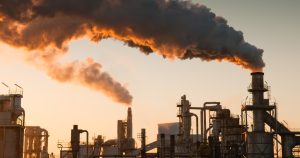
DOE has a big opportunity to decarbonize industry. Here’s how it can leverage a new program.
This blog is the second of a series of analyses being developed by a coalition of NGOs engaged in decarbonization of the U.S. industrial sector. It focuses on investment priorities for $5.8 billion in funding for industrial decarbonization in the Advanced Industrial Facilities Deployment Program (AIFDP), passed by Congress as part of the Inflation Reduction Act. We and our partners will continue to update our blogs to references one another’s work. See the recent posts by ITIF, and NRDC+RMI.
The Inflation Reduction Act made a historic down payment on climate and clean energy progress across the economy, including new investments that take aim at a notoriously tough-to-decarbonize sector: industry. A key provision in this law is the $5.8 billion Advanced Industrial Facilities Deployment Program (AIFDP), which is intended to support early-stage demonstrations of technologies and processes that could cut emissions in the industrial sector. The Department of Energy now has the opportunity to design this program to maximize breakthroughs in technologies and benefit communities.
This new industrial program fills two important gaps to achieve our climate goals. First, a technical gap: Industrial sectors like steel, concrete and chemicals production are difficult to fully decarbonize with existing solutions, like energy efficiency measures, electrification, and the use of clean electricity. While these tools are all critical and should be deployed extensively where they can, they are not as effective at addressing emissions resulting from high-heat applications or chemical processes. We’ll need to innovate new solutions.
The second gap is about the innovation process: There’s a known phenomenon that our innovation pipeline, which converts ideas into solutions, is uneven. While public spending tends to support early-stage R&D and industry tends to fund late-stage scale-up and commercialization, there’s a missing middle — the “Valley of Death” — where neither governments nor industry provide sufficient funding for the early stages of piloting larger projects and demonstrations. Its where good ideas can fall by the wayside.
Enter the Office of Clean Energy Demonstrations (OCED), the new DOE office with $20B from the bipartisan Infrastructure Investment and Jobs Act (IIJA) with a focus on scaling up emerging technologies through demonstration projects. Through the AIFDP, OCED can help solve both problems, providing catalytic support for key solutions and positioning them for additional investment and commercialization in the next couple of decades. As a government entity, it can also set a high standard for best practices in community engagement and positive impacts on the ground.
Which investments should OCED pursue to have catalytic impact?
We have a few pointers, based on EDF’s 2021 Climate Innovation Blueprint. In partnership with Evolved Energy Research, the Blueprint uses energy system modeling to project the emissions impact of potential cost- and performance-breakthroughs of 15 climate technologies under different climate policy scenarios, including one that achieves net-zero emissions in the U.S. by 2050. A key innovation in this work was that it captured interactions among technologies and analyzed the potential for breakthroughs. While data limitations allowed only a few industrial technologies to be included in the analysis, EDF’s Blueprint offers key lessons around targeting early-stage investments in ways that may maximize cost- and performance- breakthroughs for climate technologies, increasing the likelihood that industry adopts those technologies.
Here are six main lessons from this analysis:
- Target solutions with high-impact potential: OCED should target solutions that have the potential to transform emissions-intensive sectors to a degree necessary to meet climate targets. These investments are inherently high-impact — we should deploy them where there is a high potential for emissions reductions. OCED may also consider developing metrics to track and report the success of these investments over time.
- Ensure positive outcomes for communities: Emissions impacts should not be the only metric for success. OCED should put forward a specific, measurable definition of “transformative” which considers the impact of technology breakthroughs on local air pollution and other community considerations in the long term. Transformation of the industrial sector should not come at the expense of nearby communities, especially those who continue to suffer from the burdens of environmental injustice and legacy pollution. As they’ve taken steps related to the Hydrogen Hubs program, OCED should deepen DOE’s ask of applicants to report non-climate impacts of the technologies, submit community benefits plans, and demonstrate early and meaningful partnership.
- Consider a technology’s impact on cumulative emissions: Time is ticking, and we should consider the fact that solutions that are 10 years away will lose 10 years of emissions reductions that a more mature option may be able to capture sooner. Using clean hydrogen to reduce iron in the steelmaking process – a fundamentally different production process from traditional steelmaking – could avoid cumulative emissions over time.
- Prioritize solutions that have few alternatives: In addition to cumulative impact, policymakers should consider when a given solution doesn’t come with many alternatives. Certain ‘breakthrough’ technologies may require early investment and some degree of lead time to unlock their full potential. In these cases, failure to invest today may make it difficult to deploy critical technologies down the road.
- Assess where solutions can have positive “spillover” effects: Another element to consider is the positive interactions among innovations. If a breakthrough in a particular technology helps curb emissions and unlocks additional breakthroughs in other areas, then investment in that technology now could have exponential payoffs in the future. For example, carbon that is responsibly captured or removed could be utilized to produce low-carbon fuels for aviation or shipping, support the development of carbon management infrastructure, and provide new decarbonization solutions for other hard-to-abate sectors.
- Coordinate spending with other programs: OCED should align AIFDP investments with other federal funding for the industrial sector, such as R&D investments in Buy Clean — a set of policies which uses federal purchasing power to drive demand for low-carbon goods. While AIFDP alone cannot account for the overall insufficiency of public sector investment in reducing industrial emissions, OCED can use this opportunity to ensure that key solutions receive balanced funding across the innovation pipeline, depending on their technology readiness levels. Further analysis on the interaction of federal innovation investments may illuminate the effectiveness of this strategy, especially as funding from IIJA and IRA is doled out.
Identifying the front-runners and driving investment in solutions that are transformational is no small task. To get on the pathway to a safer, stable climate, we have to confront our toughest obstacles head-on.












